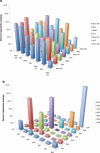Functional classification of class II human leukocyte antigen (HLA) molecules reveals seven different supertypes and a surprising degree of repertoire sharing across supertypes
- PMID: 21305276
- PMCID: PMC3626422
- DOI: 10.1007/s00251-011-0513-0
Functional classification of class II human leukocyte antigen (HLA) molecules reveals seven different supertypes and a surprising degree of repertoire sharing across supertypes
Abstract
Previous studies have attempted to define human leukocyte antigen (HLA) class II supertypes, analogous to the case for class I, on the basis of shared peptide-binding motifs or structure. In the present study, we determined the binding capacity of a large panel of non-redundant peptides for a set of 27 common HLA DR, DQ, and DP molecules. The measured binding data were then used to define class II supertypes on the basis of shared binding repertoires. Seven different supertypes (main DR, DR4, DRB3, main DQ, DQ7, main DP, and DP2) were defined. The molecules associated with the respective supertypes fell largely along lines defined by MHC locus and reflect, in broad terms, commonalities in reported peptide-binding motifs. Repertoire overlaps between molecules within the same class II supertype were found to be similar in magnitude to what has been observed for HLA class I supertypes. Surprisingly, however, the degree to which repertoires between molecules in the different class II supertypes also overlapped was found to be five to tenfold higher than repertoire overlaps noted between molecules in different class I supertypes. These results highlight a high degree of repertoire overlap amongst all HLA class II molecules, perhaps reflecting binding in multiple registers, and more pronounced dependence on backbone interactions rather than peptide anchor residues. This fundamental difference between HLA class I and class II would not have been predicted on the basis of analysis of either binding motifs or the sequence/predicted structures of the HLA molecules.
Figures
References
-
- Alexander J, Sidney J, Southwood S, Ruppert J, Oseroff C, Maewal A, Snoke K, Serra HM, Kubo RT, Sette A, et al. Development of high potency universal DR-restricted helper epitopes by modification of high affinity DR-blocking peptides. Immunity. 1994;1:751–761. - PubMed
-
- Axelsson-Robertson R, Weichold F, Sizemore D, Wulf M, Skeiky YA, Sadoff J, Maeurer MJ. Extensive major histocompatibility complex class I binding promiscuity for Mycobacterium tuberculosis TB10.4 peptides and immune dominance of human leucocyte antigen (HLA)-B*0702 and HLA-B*0801 alleles in TB10.4 CD8 T-cell responses. Immunology. 2010;129:496–505. - PMC - PubMed
-
- Berretta F, Butler RH, Diaz G, Sanarico N, Arroyo J, Fraziano M, Aichinger G, Wucherpfennig KW, Colizzi V, Saltini C, Amicosante M. Detailed analysis of the effects of Glu/Lys beta69 human leukocyte antigen-DP polymorphism on peptide-binding specificity. Tissue Antigens. 2003;62:459–471. - PubMed
-
- Boitel B, Blank U, Mege D, Corradin G, Sidney J, Sette A, Acuto O. Strong similarities in antigen fine specificity among DRB1* 1302-restricted tetanus toxin tt830-843-specific TCRs in spite of highly heterogeneous CDR3. J Immunol. 1995;154:3245–3255. - PubMed
Publication types
MeSH terms
Substances
Grants and funding
LinkOut - more resources
Full Text Sources
Other Literature Sources
Research Materials



